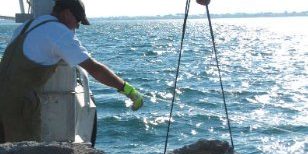Hydrobiology and Sustainability Oceans have partnered to trial the use of hydroacoustics to monitor biomass in artificial reef systems – a necessity for evaluating the effectiveness of fisheries management plans.
Monitoring artificial reefs is an important tool to determine the return on investment for fisheries management. However, common sampling methods are labour intensive, provide only relative abundance measures and typically only monitor one small section of an artificial reef.
To try to overcome some of these problems Sustainable Oceans and Hydrobiology partnered to trial the use of digital hydroacoustics in Moreton Bay (Queensland). Hydroacoustics is unaffected by visibility, does not scare fish away and can sample a large volume of water over, around and between artificial reef modules. We used high end digital sonar equipment and processing software that calculates biomass from the number and strength of the returned echoes. It can cover large areas quickly, we can monitor fish in their natural environment without them responding to the sampling, and data collection is not dependent on visibility (or depth for most reef deployments).
As this was a proof‐of‐concept trial, the analyses have been limited in extent, but the results show clearly that the older Harry Atkinson Reef had the greatest associated aggregations of biomass, including some impressive schools. The newer artificial structures are still in development, and at the time of sampling included only loose associations of a few reef balls per reef unit. Nonetheless, the units at Coochiemudlo already were associated with substantial aggregations of fishes. The Peel Reef is nearer to some natural rocky reefs, which were shown to have existing associated fish aggregations, but potentially far enough from them to not yet form an attractive alternative reef site. There are very few solid substrates near Coochiemudlo, which may explain why more biomass was attracted to this younger artificial reef. This exercise was mainly a single snapshot. Over time, biomass change could be readily monitored on these three reefs using these techniques and we would then be able to undertake a more in-depth assessment of effectiveness and influence of reef design using this method.





